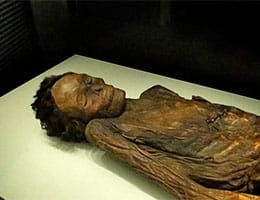 The etymology of mummy takes us to the classical Arabic mūmiyā» , a word that alluded to the bitumen used in the embalming of corpses . This term, in turn, derived from the Persian mum , which can be translated as "wax" .
The etymology of mummy takes us to the classical Arabic mūmiyā» , a word that alluded to the bitumen used in the embalming of corpses . This term, in turn, derived from the Persian mum , which can be translated as "wax" .
A mummy is a corpse that, either by a man-made procedure or naturally, was desiccated without rotting . The mummies, therefore, do not enter into putrefaction despite the passage of time.
In most regions of the planet, when a human being or an animal dies, a degradation process begins. However, in certain areas, this does not happen since cold, dryness and other conditions prevent the appearance of microorganisms: in this way, the body becomes mummified.
The Llullaillaco children are an example of natural mummies. These are three small Inca people who died in a ritual about five centuries ago, whose remains were found near the summit of the Llullaillaco volcano, in the Argentine province of Salta . Due to the environmental characteristics, the bodies became mummies that were preserved in very good conditions.
For religious reasons, various cultures developed artificial mummification with the intention of preserving corpses. In Ancient Egypt the practice had great ritual importance, as it prepared the deceased for the journey to the Afterlife .
There is a popular legend linked to a supposed curse on Egyptian mummies , which would attack those who try to desecrate their tombs. Throughout history, books, comics, TV series and films inspired by this belief were created, such as the film trilogy starring Brendan Fraser .
The so-called sokushinbutsu are Buddhist mummies whose process begins while the monk is still alive. This is achieved through the extreme practice of asceticism , the philosophical doctrine that pursues the purification of the spirit through the denial of physical pleasures, since it goes against one's own survival instinct.
Although only twenty-four mummies of this type are known to date, it is estimated that many monks tried it and failed. Most historians agree that the monk known as Kukai , who founded the Shingon Buddhist school towards the end of the 8th century in Japan, learned the technique of sokushinbutsu in China, specifically from the Tang Dynasty .
 In Tenerife, an island in the autonomous community of the Canary Islands located in the Atlantic Ocean, the remains of Guanche mummies are found. They belong to an aboriginal tribe of the same name, who practiced mummification before the Canary Islands were conquered by the Crown of Castile, that is, in the period before the 15th century.
In Tenerife, an island in the autonomous community of the Canary Islands located in the Atlantic Ocean, the remains of Guanche mummies are found. They belong to an aboriginal tribe of the same name, who practiced mummification before the Canary Islands were conquered by the Crown of Castile, that is, in the period before the 15th century.
Although many Guanche mummies are not preserved due to acts of desecration and looting, some were able to be rescued and studied in detail. One of the characteristics that stands out the most to experts is that the embalming techniques are very similar to those used by the ancient Egyptians.
Another of the best-known mummies is the one called Juanita , belonging to the Inca culture and found in the region of Arequipa, in Peru, in 1995. It was discovered by Johan Reinhard and Miguel Zárate , an archaeologist and a mountain climber, respectively, during a expedition to the Ampato volcano, currently inactive. The first thing that caught their attention was its excellent state of conservation and the presence of many offerings around it, among which were some statuettes called illas and various plants.
The following year, they exhibited it at a headquarters of the National Geographic Society in Washington, United States of America, in a properly heated urn and then donated it to the Catholic University of Santa María de Arequipa .
